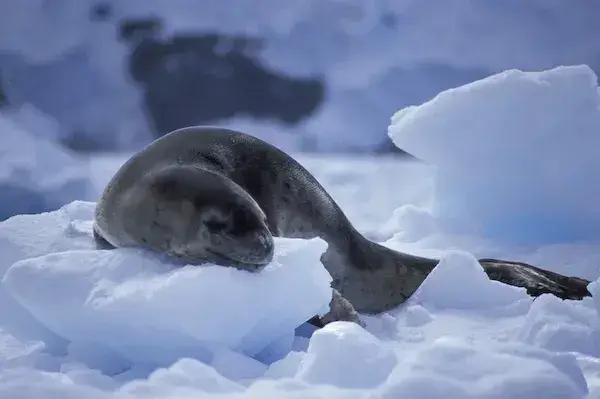Hope Bay at the northeast tip of the Peninsula is approached through the Antarctic Sound, where incredible tabular icebergs can be spotted. It was the site of a British station (Base D) closed in 1964 and now is home to the large Argentine Esperanza. The most attractive spot with a vast Adélie penguin colony lies adjacent to this station. There is also a historic ruin of a stone hut, where three men from Otto Nordenskjöld’s Swedish expedition survived the 1903 winter.
Just outside the Antarctic Sound.in the northern Weddell Sea is Paulet Island where enormous numbers of Adélie penguins breed on its rocky slopes, and there is a big colony of Antarctic Blue-eyed Shags as well as the nest sites of Wilson’s storm-petrels. It is of historical interest, too, as you can find the substantial remains of a stone hut wintering site for 20 of the crew of the ship of Nordenskjöld expedition which was crushed and sank in February 1903.
In the southern side of the Peninsula, humpback whales can often be seen in Gerlache Strait. Nearby it, Cuverville Island supports a compact colony of gentoo penguins as well as breeding south polar and brown skuas, and nesting Wilson’s storm-petrels.
Farther south, in Paradise Harbour, you come across the Argentine Almirante Brown station, which was partly burnt down in 1984, and not far away on the Danco Glacier — Danco Island.
Set in the midst of a bustling colony of gentoo penguins is Gabriel González Videla station belonging to Chile. The site is known as Waterboat Point, after two British scientists who chose to winter here in 1921, using a whaler’s water-boat for part of their shelter hut (its remains can still be seen).
At the foot of which is the sheltered anchorage of Port Lockroy (approached via the great Neumayer Channel) lies Wiencke Island. Surrounded by high mountains, the site has a large and busy gentoo penguin rookery with a small contingent of blue-eyed shags that nest near the shore.
Palmer Station, a United States station, was established in 1965 and named after Nathaniel B. Palmer, a sealer who worked at the South Shetland Islands in 1820. It is well situated for studies of birds, seals, and the marine ecosystem, as well as other research projects. Near Palmer Station, visitors are welcome to explore Torgersen Island, where crabeater and leopard seals are also seen.
Sailing south is the Lemaire Channel, a deep, narrow cleft between Booth Island and the mainland of the Antarctic Peninsula. The Lemaire is most often cited as the most beautiful in the area, and if not blocked by ice, sailing between the channel’s sheer cliffs it’s a memorable experience. Seals are often seen on ice floes and minke whales may be encountered.
There are several islands with penguin colonies, such as Pleneau, Hovgaard, and Petermann south of the Lemaire. Elephant seals, especially young males, often haul out onto the flat rocks to enjoy communal wallows in the summer sunshine. Petermann Island is where the southernmost colony of gentoo penguins that can be seen.
Just south of the Antarctic Circle, Adelaide Island is the site of the British Rothera Station. Scientific studies here concentrate on geophysical and atmospheric physics with the aid of a satellite receiving system called ARIES Antarctic Reception of Imagery of Environmental Sciences.
If you are looking forward to visit and explore these sites during your next voyage, get to us with your inquiries and we’ll help you plan the best voyage of your life! Contact us here


